In the heart of the misty mountains of Northern Vietnam lies a unique cultural treasure: the traditional markets of ethnic minorities. These weekly gatherings transcend mere commerce to become true celebrations of mountain life, where each encounter tells a millennia-old story.
The magic of ethnic markets
Imagine... You stroll through a bustling street in the early morning light. The fresh mountain air mixes with the aromas of medicinal herbs and traditional dishes. Around you, Hmong women in their finely embroidered costumes haggle over the price of vegetables, while Dao men discuss over glasses of homemade corn alcohol. Children run between the stalls, their laughter blending with the lively conversations of the vendors.
These markets are much more than simple commercial exchange places. They represent the vibrant heart of the social life of ethnic minorities. This is where news circulates, marriages are negotiated, friendships are formed, and traditions are passed down from generation to generation.
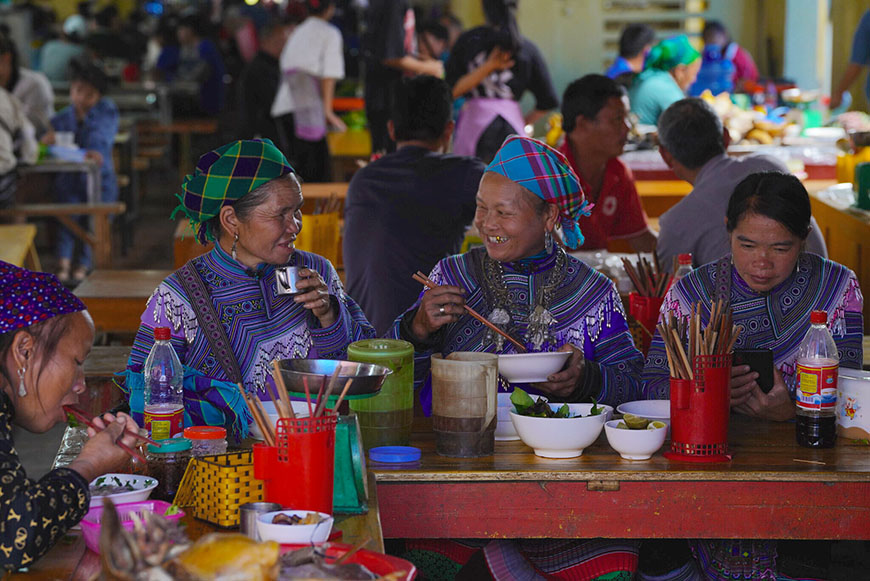
Breakfast time on Sapa market - Source : Mr Linh's Adventures
Exploring local flavors
The cuisine of ethnic markets reflects the richness of local biodiversity and the ancestral know-how of mountain communities. Each dish tells a story, each ingredient has its meaning in the local culture. Traditional preservation techniques (smoking, fermentation, drying) help preserve food without refrigeration and create unique flavors found nowhere else.
The markets are also places for sharing culinary knowledge, where different ethnic groups exchange preparation secrets and traditional recipes. It's the perfect opportunity for visitors to discover an unknown aspect of Vietnamese cuisine, quite different from that of the big cities.
Important note: It is recommended to be accompanied by a local guide to discover these specialties, as some can be very spicy or have particular preparation methods. The guide can also explain the cultural significance of each dish and help you choose the best producers.
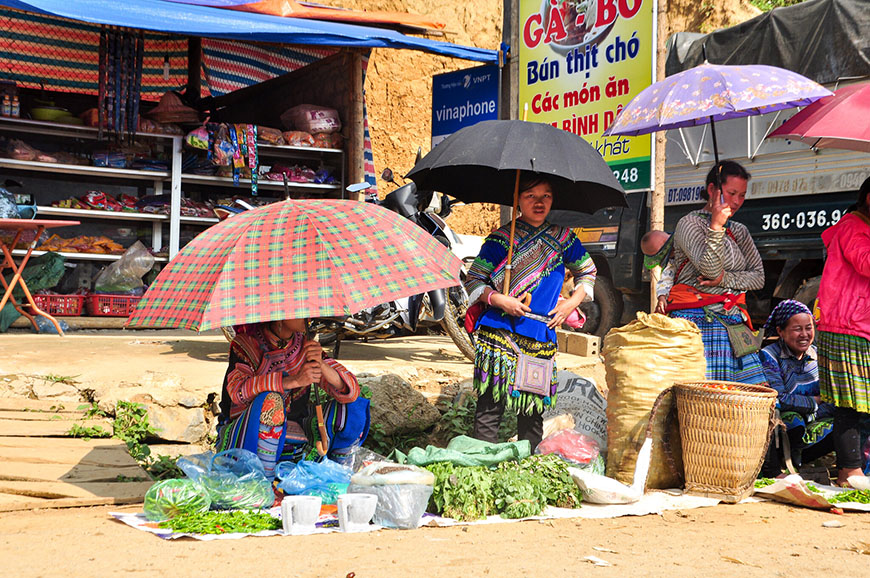
The iconic market of Bac Ha
The most beautiful markets to explore
Bac Ha Market: The star of Upper Tonkin
Every Sunday, this iconic market transforms the small town of Bac Ha into a burst of colors. It is the largest and most famous ethnic market in the region. At dawn, vendors arrive from surrounding villages, some having walked several hours to set up their stalls. The traditional costumes of the Flower Hmong people, recognizable by their pleated skirts with vibrant geometric patterns, create a living kaleidoscope of red, blue, and purple.
Location: Located in Bac Ha town, Bac Ha district, Lao Cai province, about 65 kilometers from downtown Lao Cai.
Frequency: Hmong, Dao, Tay, Nung and Phu La meet here every Sunday.
Culinary specialties
- "Lẩu gà đen": local black chicken hotpot with mountain herbs
- Traditional corn alcohol "rượu ngô", served in ceramic jars
- "Thắng cố": traditional Hmong stew with various meats
- Wild mountain mushrooms
- Forest honey harvested by local ethnic groups
Practical tip: Arrive early, around 6 am, to see the vendors set up their stalls and enjoy the authentic atmosphere before the arrival of tourists. The livestock market, particularly lively, takes place in a separate area where horses and buffaloes are negotiated in an electric atmosphere.
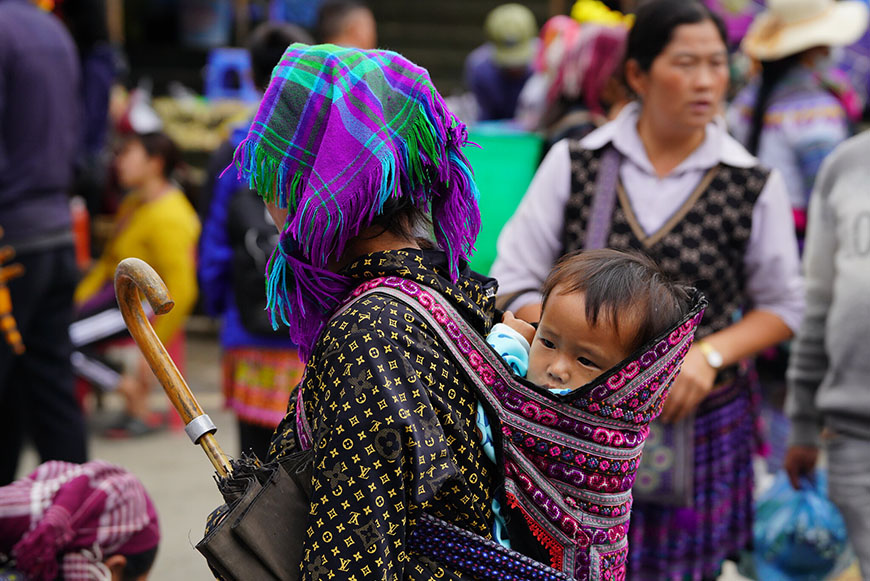
Sapa Market, a must-see in Lao Cai Province - Source : Mr Linh's Adventures
Sa Pa market: the beating heart of the mountains
The Sa Pa market is a must-see for anyone wishing to immerse themselves in the lives of North Vietnam's ethnic minorities.
Location: Situated in the heart of the town of Sa Pa, in Lao Cai province, the market is within easy walking distance of hotels and homestays.
Frequency: While the market is held every day of the week, Sunday mornings are the busiest. The Hmong, Dao and Zao ethnic groups gather here to exchange products and know-how.
Culinary specialties
- Lợn Cắp Nách (Pork carried under the arm): the meat of this small pig is renowned for its tenderness and can be cooked in a variety of ways, including grilled or roasted
-Gà Đen (Black Chicken). Sapa black chicken is another popular dish, often prepared grilled or stewed. Its flesh is tasty and goes well with fresh herbs and spices-“Thắng cố”: traditional Hmong stew made from horse meat, bones and various internal organs, all simmered with a multitude of herbs and spices.
- Đồ Nướng (Barbecue). Meat skewers and other grilled foods are very popular in Sapa, especially in the evenings when temperatures drop. Visitors can enjoy a variety of grilled meats in a convivial atmosphere.
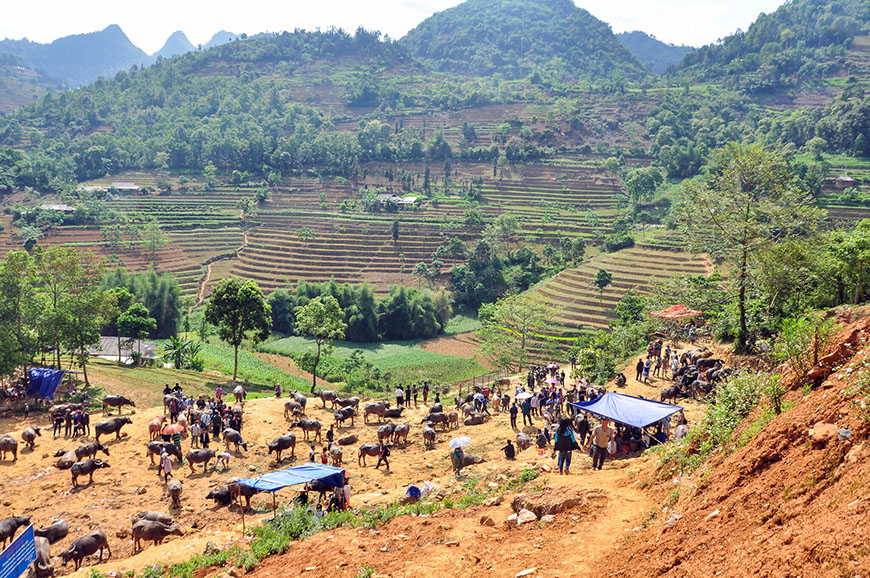
Can Cau is famous for its buffalo market - Source : Mr Linh's Adventures
Can Cau Market: Preserved authenticity
More confidential, this Saturday market offers a more intimate experience. The Flower Hmong sell their superb traditional textiles and ancestral medicinal herbs. The relative isolation of the area has preserved its authenticity, away from mass tourism. Transactions are still often conducted by barter, particularly for livestock (the Can Cau market is notable for its buffalo market).
Location: Approx. 20 km north of Bac Ha market, also in Lao Cai province.
Frequency: Held every Saturday morning, with a majority of Flower Hmong, Black Dao and Phu La people.
Culinary specialties
- "Xôi ngũ sắc": five-color sticky rice, a Hmong specialty
- Smoked black buffalo meat
- Mountain medicinal herbs prepared in herbal teas
- Seasonal fruits from the heights: mountain peaches, wild plums

Red Dao woman on Coc Ly market - Source : Collected
Coc Ly Market: The gem by the water
Nestled by the Chay River, this Tuesday market is a living tableau where four different ethnic groups mingle. The natural setting makes it a particularly photogenic place. The Dao women, recognizable by their large red turbans, offer exceptionally fine embroideries, the result of several months of work.
Location: On the banks of the Chay River, about 12 kilometers from Bac Ha market and 35 kilometers from Bac Ha.
Frequency: Held every Tuesday morning, watched by Hmong, Dao and Nung people.
Culinary specialties
- Fresh fish from the Chay River
- "Cơm lam": rice cooked in bamboo stems
- "Thịt trâu gác bếp": buffalo meat dried above the fire
- Fermented bamboo shoots
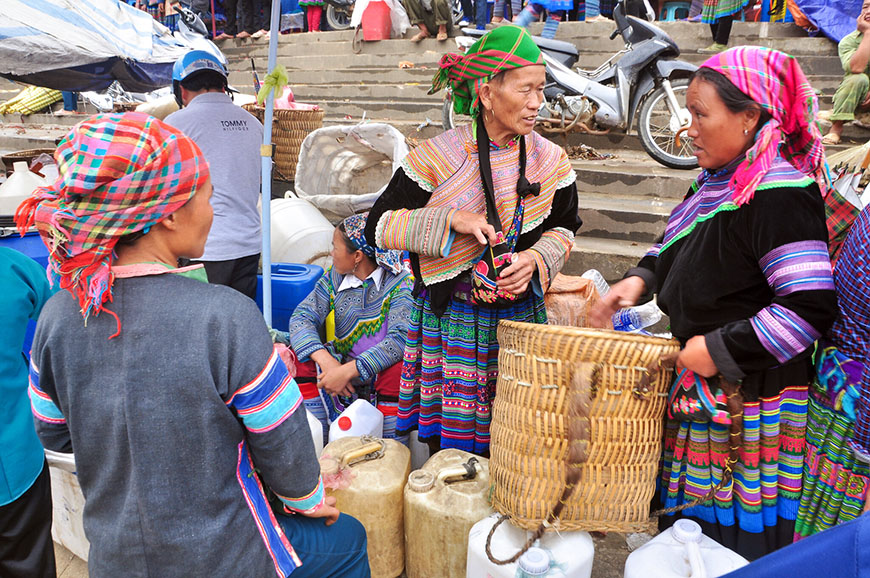
Hmong woman selling rice win on Dong Van Market - Source : Mr Linhs'Adventures
The new must-visits
Dong Van Market
An essential addition to your itinerary, this Sunday market is held in an old citadel. The cobbled streets of the old quarter come alive at dawn, creating a unique atmosphere where history seems suspended. Unique specialty: the precious stone market, where locals sell jade and semi-precious stones. Connoisseurs will also appreciate the corn wine, a renowned local alcohol.
Location: Located in the heart of Dong Van town, Ha Giang province, about 150 kilometers northeast of Ha Giang city.
Frequency: Every Sunday morning, Hmong, Tay, Dao and Nung converge here.
Culinary specialties
- "Phở chua": sweet and sour pho soup, a local specialty
- Buckwheat pancakes with herbs
- "Bánh cuốn" stuffed with mountain mushrooms
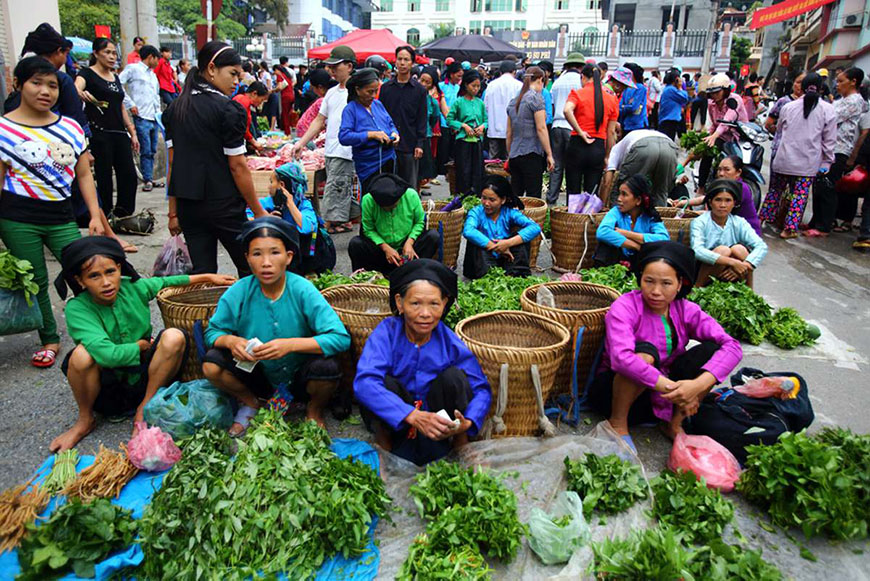
Hoang Su Phi Market - Source : Local Vietnam
Hoang Su Phi Market
Less known but equally fascinating, this monthly market (the 15th day of the lunar calendar) is known for its artisanal textiles and rare traditional dishes. The region is also famous for its terraced rice fields, classified as national heritage.
Location : On Vinh Quang's main street
Frequency: Tay, Nung, Dao and H'Mong gather here every Sunday, from dawn to midday.
Culinary specialties
- Red rice from ancestral terraces
- Green tea from ancient plantations
- "Lợn cắp nách": free-range black pigs
Practical tips
Optimal timing
- High season: October to April (dry climate and pleasant temperatures)
- Best hours: 6 am-11 am (activity decreases in the afternoon)
- Avoid the rainy season (May-September) when paths can become difficult
- Market days vary by location, allowing you to visit several markets during the same trip
Transport and accommodation
- From Hanoi: night trains or buses
- On-site: motorcycle taxis, jeeps with drivers, or local minibusses
- Accommodation: traditional homestays or simple hotels in main towns
- Local guides: highly recommended for a more enriching experience
These traditional markets represent much more than a mere tourist attraction. They are the vibrant heart of mountain communities, a place where millennia-old traditions continue to thrive. Each visit becomes a privileged immersion into an authentic Vietnam, far from the beaten paths, a unique opportunity to discover a preserved way of life and contribute to its sustainability.
Some ideas to meet the ethnics minorities on traditional markets: